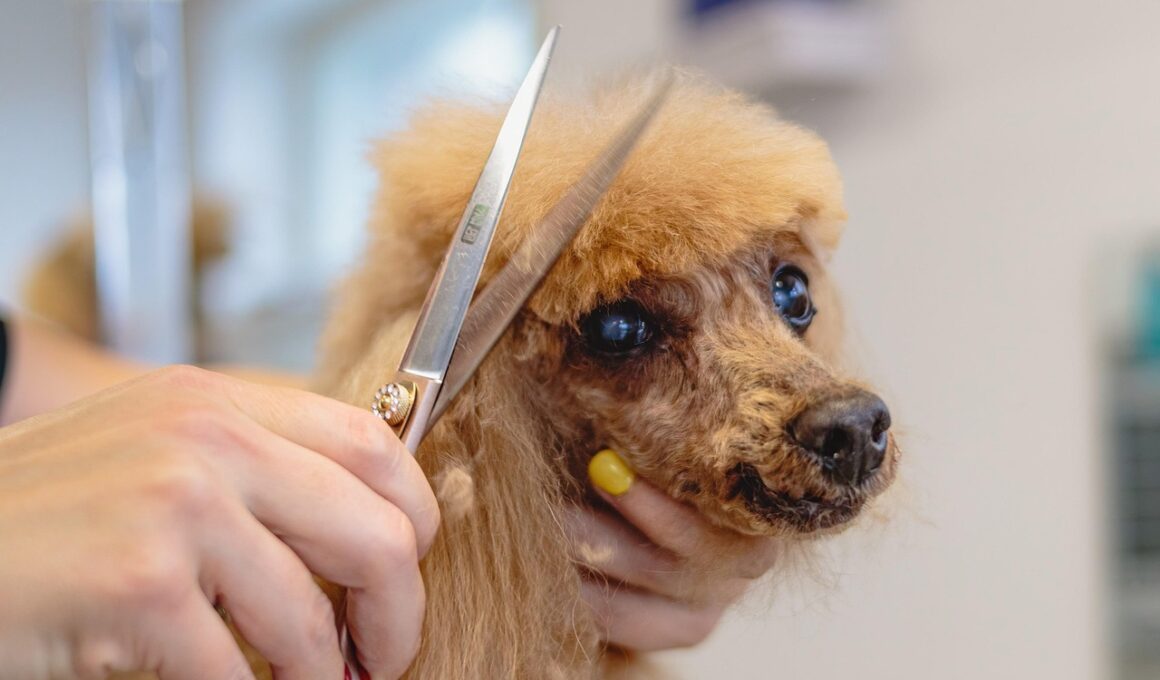How to Handle Grooming Anxiety in Dogs
Grooming your dog is an essential aspect of responsible pet ownership, yet many dogs experience anxiety during grooming sessions. Understanding the root causes of this anxiety is crucial for effectively addressing it. Common triggers include unfamiliar noises, the feel of water, and the sight of grooming tools. To help alleviate your dog’s fear, it is important to approach grooming calmly and progressively. Start by introducing grooming tools gradually, allowing your dog to sniff and examine them without any pressure. Establish a calm and comfortable environment with soothing music or familiar scents. Moreover, rewarding your dog with treats and praise for positive behavior will encourage relaxation. Through a combination of patience and positive reinforcement, your dog will begin to associate grooming with positive experiences, fostering a sense of security. Additionally, consider scheduling shorter grooming sessions that focus on one aspect at a time, such as brushing or nail trimming. This will minimize overwhelm while ensuring that your dog remains comfortable during the process. Each positive experience will contribute to reducing anxiety over time, allowing great trust to develop between you and your furry friend.
Building a bond with your dog is vital, and grooming presents an excellent opportunity. Begin with gentle touches and strokes when grooming, enhancing your dog’s trust. Let your dog see the grooming tools beforehand to make them familiar. It’s also worthwhile engaging in structured playtime after grooming to build positive associations. If your dog particularly dislikes a specific part, like nail clipping, consider using a style that’s less intrusive or explore alternative techniques. Always observe your dog’s body language; if they show signs of distress, take a break. Notice the signals they send, such as stiffening or trying to escape. By acting on these signals promptly, you can alleviate anxiety and eventually retrain your dog to accept grooming positively. Frequent short sessions are more beneficial than infrequent long ones. Moreover, consistency is essential in establishing a routine, as dogs thrive on predictability. Create a schedule based on your dog’s needs, and communicate that grooming is a friendly, healthy activity. In this way, you can replace anxiety with confidence, allowing your dog to enjoy grooming and enhancing their overall wellbeing.
Choosing the Right Tools for Grooming
Selecting the correct grooming tools can significantly reduce anxiety in your dog. Dogs have various coat types, and using the appropriate brush can make a vast difference. For example, slicker brushes are excellent for coats that tangle easily, while rubber-bristle brushes work wonders for short-haired dogs. Moreover, consider the comfort of your dog; ergonomic tools designed for ease of use can make grooming more enjoyable. A good pair of nail clippers can also alleviate stress associated with nail care. Electric or rechargeable clippers might be gentler on your pup. Ensure to introduce each tool slowly, allowing your dog the opportunity to adjust. You can also involve treats when your dog engages positively with grooming tools. Additionally, certain handheld massagers can provide a soothing touch, thus decreasing anxiety levels. Many pet parents have noted a significant reduction in nervousness after using tools designed for comfort. When choosing tools, conduct thorough research and seek recommendations from professionals. Investing in good quality supplies is key to making grooming a pleasant routine for both you and your dog.
Another important aspect of managing grooming anxiety in dogs is ensuring relaxation techniques during the process. Practicing calming techniques can help ease your dog’s nerves. One effective method is to use aromatherapy; certain essential oils have calming properties when diffused or gently applied to a bandana around your dog’s neck. Always check and confirm that the oil is safe for canine use before you start. Providing a comfortable spot where your dog feels secure during grooming also works wonders. Using familiar blankets or cushions can help to create a safe space. It’s critical to incorporate breaks during grooming sessions, particularly if your dog becomes anxious. Teach your dog the ‘settle’ command, which can help manage their excitement and anxiety. Work at your pet’s pace; gradually increase the duration of grooming sessions as they become more accustomed. After grooming, share a quiet time together, further reinforcing their comfort level. Positive reinforcement can manifest through treats or affection, aiding the overall grooming experience. This continuity allows your furry friend to associate grooming with a calm and enjoyable encounter, reducing future anxiety during the sessions.
Professional Help and Training Options
In certain situations, seeking professional assistance may be beneficial for managing grooming anxiety. Certified dog trainers and groomers can provide expert guidance tailored to your dog’s specific needs. Additionally, attending grooming classes can expose your dog to various grooming experiences, fostering a more familiar atmosphere. It can be advantageous to work with a trainer who specializes in anxiety issues, ensuring that you receive the best possible techniques to apply at home. Furthermore, some dogs may benefit from anxiety wraps or calming vests designed to provide a sense of security during grooming. Talk to your veterinarian about any behavioral concerns and inquire about behavior modification programs. Professional groomers often have experience working with anxious dogs, offering specialized techniques that can ease your dog’s fears. Finding the right trainer or groomer can make a world of difference; ensure you communicate openly about your dog’s anxiety. Sometimes, medication may also be suggested to help manage high levels of anxiety during grooming sessions. Following these structured paths not only equips you with helpful strategies but can foster deeper bonds between you and your dog, cultivating trust over time.
Ultimately, understanding your dog’s unique personality and sensitivity is paramount when addressing grooming anxiety. Each dog is different; what works for one may not work for another. Take time to bond with your dog while grooming to ensure they feel secure. Consider using calming electronics such as white noise machines or calming music during grooming sessions to create a soothing environment. Gradually desensitize your dog to the sounds of grooming equipment such as clippers or dryers, allowing them time to adapt at their own pace. Additionally, try providing your dog with safe chew toys to occupy them during grooming. These techniques can distract and assure them that grooming can be a comfortable experience. Create a calm atmosphere before starting; having a comfortable mat or bedding can help too. Consistency remains crucial; establishing a regular schedule creates predictability, allowing your dog to adjust mentally and emotionally. Over time, patience and mindful practice can enable you and your dog to enjoy grooming without anxiety, ultimately ensuring their coat remains healthy and well-maintained.
Conclusion: Transforming Grooming into a Bonding Experience
In conclusion, grooming your dog should not be a source of anxiety but a joyful bonding experience. Understanding the triggers of grooming anxiety can significantly improve the process for both you and your furry friend. By gradually introducing grooming routines and using appropriate tools, you can cultivate a sense of trust and comfort. Consistent positive reinforcement and desensitization techniques will make a huge difference over time, allowing your dog to experience grooming as a pleasant activity. Additionally, training and professional help can provide specialized strategies tailored for your dog’s personality. Throughout the grooming journey, always keep your dog’s comfort and well-being as priorities. The time invested in transforming grooming from a dreaded chore into an enjoyable bonding moment is invaluable. Not only will this strengthen your relationship, it will also contribute to your dog’s overall happiness and health. Embracing a compassionate approach can mitigate anxiety, ensuring that grooming sessions become a routine part of enjoying life together. So let’s turn grooming anxiety into a positive experience where both you and your dog can foster comfort and trust, creating lifelong memories together.


